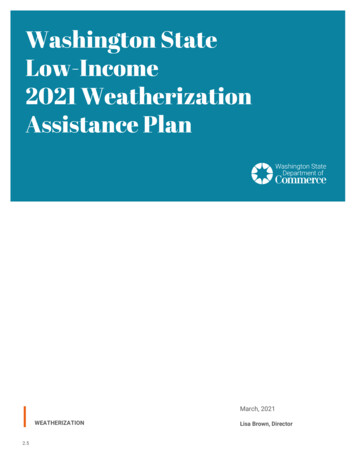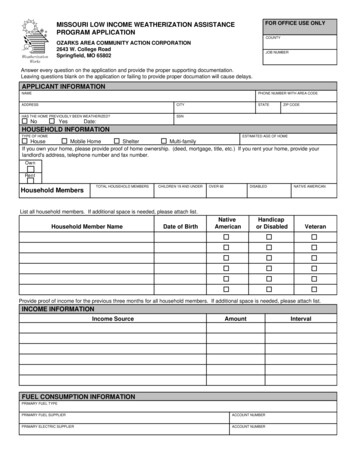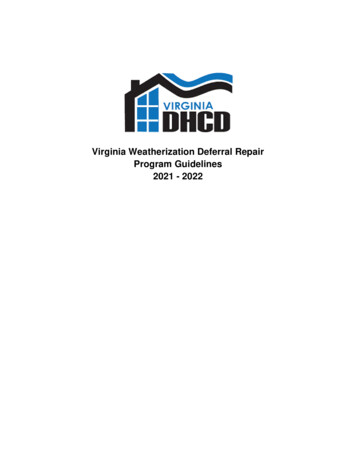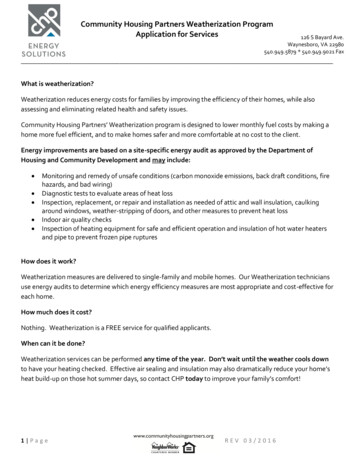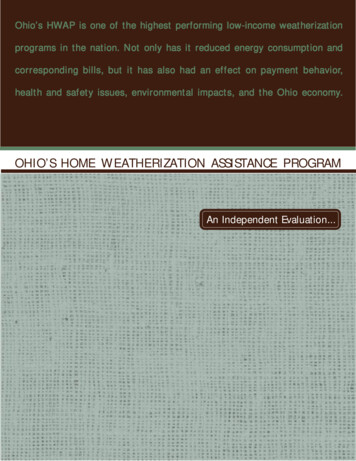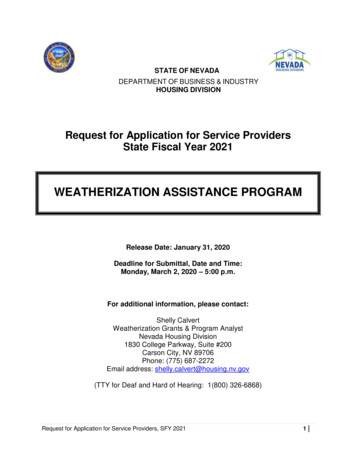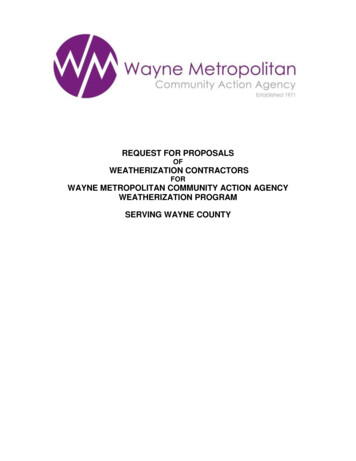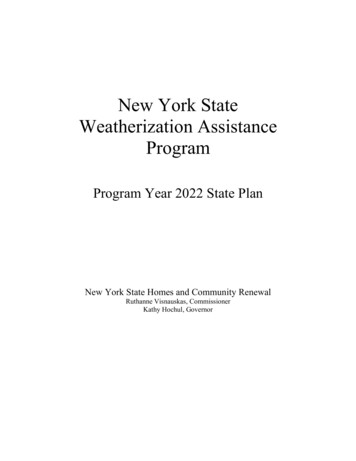
Transcription
New York StateWeatherization AssistanceProgramProgram Year 2022 State PlanNew York State Homes and Community RenewalRuthanne Visnauskas, CommissionerKathy Hochul, Governor
2022 Weatherization State Planii
2022 Weatherization State PlanTable of ContentsExecutive SummarySection I- IntroductionSection II – FundingII.1 Funding SourcesII.2 Funding for the 2021-22 Program YearII.3 Funding for the 202-23 Program YearSection III – BudgetIII.1 Program BudgetIII.2 Funding Allocation FormulaIII.3 Subgrantee SelectionIII.4 Subgrantee LaborSection IV – Program ImplementationIV.1 Subgrantee ContractsIV.2 Dwelling Unit ProductionIV.3 Energy SavingsIV.4 Leveraging and Coordination with Other ProgramsIV.5 Public Hearings on the State PlanIV.6 MiscellaneousSection V – Program ManagementV.1 EligibilityV.2 Areas to be ServedV.3 Priorities for AssistanceV.4 Climactic ConditionsV.5 Type of Weatherization Work to be DoneV.6 Analysis of EffectivenessV.7 Health and SafetyV.8 Program ManagementV.9 Energy Crisis and Disaster PlanAppendix A - Policy Advisory Council MembersAppendix B - Allocation FormulaAppendix C - Subgrantee Allocation ChartAppendix D - Health and Safety Planiii111122234566779121214141819192125262834
2022 Weatherization State PlanExecutive SummaryThe New York State Weatherization Assistance Program Plan for Program Year 2022-23 servesas New York’s application to the US Department of Energy for Weatherization funds, and as the guidefor the allocation of an estimated 65.4 million in Federal residential energy conservation funding.These funds will assist more than 6,800 households across the State in 2022-23. The program isadministered by New York State Homes and Community Renewal (HCR), which has primaryresponsibility for the State’s housing and community renewal programs. HCR is uniquely positioned todeliver Weatherization services, in coordination with other State agencies and our local partners.The purpose of the Program is to reduce energy and utility costs by installing energy efficiencymeasures in the homes of income-eligible persons, especially homes occupied by the elderly, personswith disabilities, and families with children. Program funds are targeted to the most efficient and costeffective efficiency measures, determined from a comprehensive on-site energy audit of the building.The Weatherization program reduces the State’s overall energy consumption, as well as carbonemissions that contribute to climate change. It also lessens the impact of higher energy costs on lowincome families and improves the health and safety of assisted households.New York implements the program through a network of local providers with expertise in energyefficiency. These program subgrantees provide energy efficiency services using their own trained staffand by subcontracting work to qualified weatherization contractors. Energy efficiency measures fundedby the program range from air sealing and insulating single-family homes to replacement of buildingwide mechanical systems in large apartment buildings. The program assists all types of housing,including detached single-family homes, multifamily apartment buildings, manufactured housing andgroup homes. Program services are provided in each of the State’s 62 counties.Weatherization assistance can be invaluable for low-income households in New York. TheState’s climate, with cold, snowy winters and hot, humid summers, generates a high demand for heatingfuels and electricity. Many eligible households live in inefficient, often unsafe housing that was builtwhen energy was cheap and plentiful and cannot afford the cost of weatherization work that will lowertheir utility bills. In its May 2016 Order Adopting Low Income Program Modifications and DirectingUtility Filings, the New York State Public Service Commission adopted a policy that low-incomehouseholds in the State should not have an energy burden greater than 6% of household income andcalled for State agencies to provide energy efficiency and bill-payer assistance programs. The NYSClimate Leadership and Community Protection Act (CLCPA) enacted in 2019 established aggressivetargets to transition NY’s economy away from fossil fuels, with goals to reduce carbon emissions, orgreenhouse gases, across the state by at least 85% by 2050. The CLCPA mandates that the state investresources to ensure that at least 35% of the benefits of spending, with a goal of 40%, are directed todisadvantaged communities. HCR and the Weatherization Assistance Program are key resources toimplement these policies.The American Rescue Plan and Recovery Act (ARPA) of 2021 will provide additional fundswith which the State will directly pursue CLCPA goals through a pilot program that will be delineatedin separate contracts with the subgrantees. The State also anticipates additional funds, the amount yetto be determined, through the Infrastructure Investment and Jobs Act, with which it will continue toprioritize CLCPA goals.HCR will distribute Program funding in 2022 in accordance with this Plan. The Plan followsDOE’s recommended format:1. Section One provides an overview of the Program;2. Section Two discusses the source of funds for Program Year 2022-23;3. Section Three provides details on the funding allocation formula, the program budget, andsubgrantee information.iv
2022 Weatherization State Plan4. Section Four describes program implementation, including expected production levels,estimated energy savings, other funds and public participation in the development of theplan.5. Section Five includes Program eligibility requirements, priorities for assistance, the types ofwork that will be done and details on training, technical assistance and monitoring.The Weatherization Assistance Program provides significant contributions to the State’seconomy and to the well-being of low-income residents. Each dollar invested in program activities willresult in a savings of about three dollars in energy costs over the life of the installed measures – moneythat is returned to local economies across the State. The health and safety work the Program fundsprevents illness and injury and helps preserve housing affordability.The COVID-19 pandemic had impacts on the delivery of services for the WAP Program Year2021. WAP has adjusted operations accordingly to continue to bring the benefits of the Program to thepublic while adhering to the legal requirements and Program rules.v
2022 Weatherization State PlanSection I - IntroductionThe Weatherization Assistance Program (the “Program”) is administered in New YorkState by New York State Homes and Community Renewal (HCR), through the Office ofHousing Preservation. The Program provides energy services to income-eligible individualsand families to improve the energy efficiency of their homes and to reduce their householdexpenditures for fuel. Since the inception of the Program in 1977, more than 725,000 housingunits in New York State have been made more energy efficient due to investment ofWeatherization Program funds.Priority for weatherization activities is given to households with children, the elderly,and persons with disabilities. Priority is also given to dwelling units occupied by householdsthat receive Low-Income Home Energy Assistance (HEAP), those with high fuel costs inrelation to their household income, and to properties where other state and Federal housingresources will be leveraged.Program services are delivered through a statewide network of local service providers,referred to as “subgrantees." Subgrantees include community action agencies, othercommunity-based not-for-profit organizations, and local governmental agencies. Undercontract with HCR, subgrantees conduct outreach and intake, evaluate buildings to beweatherized, install energy-saving measures, reduce on-site carbon emissions, identify andmitigate related health and safety concerns, supervise weatherization work performed by staffand subcontractors, maintain client and program files and report on production andexpenditures. HCR has the responsibility for overall monitoring and oversight and provides anongoing training program to maintain a high level of quality. HCR requires that subgranteesfollow sound internal management policies and provide skilled workmanship, high qualitymaterials, and timely production of units.Federal rules require states to submit an annual plan for administration of the program.This plan was prepared in accordance with the Final Rule for the Program (10 CFR Part 440),and with available grant guidance issued by the US Department of Energy (DOE). It includesinformation required by DOE to access funding for the program.Section II - FundingII.1 Funding SourcesHCR expects to receive funds for the program from the US Departments of Energy(DOE) and Health and Human Services, which provides HEAP funds to the State Office ofTemporary and Disability Assistance (OTDA). A portion of the State’s allocation of HEAPfunds is passed through to HCR for the WAP Program, with additional separately contractedHEAP funds received through ARPA in 2022.HCR allocates Program funding to each county based on a formula which includesfactors related to income-eligible population and climate and sets aside funds to provide aminimum level of funding for each county where the allocation formula did not generatesignificant program funding.II.2 Funding for the 2021-22 Program Year1
2022 Weatherization State PlanFor the 2021-2022 program year, HCR had 67.1 million allocated to administer theWeatherization Program. This included 26.9 million in DOE funds and 40.2 million inHEAP funds.II.3 Funding for the 2022-23 Program YearHCR anticipates availability of 65.4 million in WAP funds for Program Year 2022.This amount includes 25.2 million in DOE funds and 40.2 million of new HEAP funds.ARPA pilot funds are an additional one-time allocation of HEAP of up to 57 million, with anexpend date of September 30, 2022. The State reserves the right to extend the term.This Plan is based on DOE guidance for the Weatherization Program that was releasedafter the issuance of federal appropriations. Federal appropriations may be adjusted during thefiscal year and at that time HCR will adjust subgrantee allocations based on the final WAP andHEAP funding levels using the method described below. HCR will allow an administrationspending percentage of DOE funds to 15% overall for the grantee and subgrantee combined.HCR will provide funds to eligible subgrantees based on a formula that measures relativegeographic needs, provided the subgrantee is in compliance with applicable State and Federalprogram requirements and has successfully completed work associated with their ProgramYear 2021-22 allocation. The Program Year will begin April 1, 2022 and end March 31, 2023.See Section IV.1 for information on contract and budget periods and a detailed explanation ofallocation formulas.Section III – BudgetIII.1 Program BudgetHCR expects to receive 95.4 million in Federal funds to be available to supportProgram activities in Program Year 2022. (Final WAP allocations will include adjustmentsfrom the planning numbers reflected in WPN 22-2 final DOE appropriations for WAP.) TheDOE Program allocation for Federal Fiscal Year 2022-23 will be 25.2 million. HCR alsoexpects to receive 40.2 million in PY22 HEAP funds, or at least 10% of the allocationreceived by New York State. In addition, 30 million in prior year funds will be available inProgram Year 2022.The anticipated funding sources are summarized below:PY22 DOE FundsPY22 HEAP fundsPrior year funds, PY21 HEAP FundsTotal Available 25,229,032 40,221,336 30,000,000 95,450,368Up to 10.3 million in DOE and HEAP funding will be retained for administrative,leveraging and training and technical assistance costs.The balance of approximately 55.1 million will be allocated to subgrantees for programoperations, as described below. Subgrantee allocations are listed in Appendix C.2
2022 Weatherization State PlanARPA funds are an additional allocation of HEAP of up to 57 million not included inthe WAP budget summary above. ARPA has an expend date of September 30, 2022. The Statereserves the right to extend the term. 3.75 million is reserved for State admin, and 3 millionfor training and technical assistance. These funds will be distributed based on subgranteeproposals and capacity. Subgrantees are not required to participate in ARPA, as not everysubgrantee has the capacity to operate an ARPA contract in addition to its annual WAPcontract.III.2 Funding Allocation FormulaProgram funding is allocated by a formula which factors in climate (heating andcooling degree days) and the share of low-income households in each county (see AppendixB). This allocation methodology is based on the method used by DOE to allocate Programfunding to the states.The first factor in the allocation formula (degree days) is determined by calculating therelative heating degree days and cooling degree days for each county, compared to the Stateaverage, with cooling degree days given 1/10th the weight of heating degree days. An averagedegree day total has been established for each county using 30-year averages (1971-2000) forweather reporting stations in those counties. In counties where there were two or morereporting stations, degree days were averaged. In counties where reporting stations did nothave 30-year averages, the next closest stations were used. The average of the degree days foreach county was then divided by the average of the degree days for the State as a whole toyield a percentage. This ratio of each county's degree days to the State average (7020) is thefirst factor in the allocation formula.The second factor in the allocation formula is determined by calculating each servicearea’s number of low-income households as a percentage of all such households in theState. This number of income-eligible households was determined by using 2019 AmericanCommunity Survey 5-Year data from the US Census Bureau for householdswith estimated incomes below 35,000. This figure was then divided by the total numberof such households in the State to yield a percentage of the total low-income households foreach county.These two factors (the percentage of low-income households in each county and theratio of the county's degree days to the New York average) were multiplied to determine thefinal percentage for each county. Since the degree day factor represents the relative extent towhich each county is above or below the State average, the total of formula factors does nottotal one hundred. As a result, the final percentages were adjusted to total 100 percent overallusing an adjustment factor applied uniformly to all counties.This resulting percentage represents the portion of the total State allocation each countyis to receive. This percentage is then multiplied by the amount available for allocation byformula after setting aside funds for technical support subgrantees and minimum fundingallocations to determine each county's allocation. HCR has identified distinct service areas thathave boundaries consistent with census tracts. Each subgrantee within these counties hassigned an agreement to provide services to their designated service area. Where a subgranteeservice area includes less than one county, proportionate allocations to subgrantees are furtherdetermined using census tract data calculating the number of low-income households in eachsubgrantee's service area.3
2022 Weatherization State PlanIn some counties, application of this allocation formula does not result in enoughfunding to operate the program effectively. Most of these counties are in the colder regions ofthe State and have fewer income-eligible households than other counties. Thirty-three countiesreceive a formula allocation of less than 400,000. For Program Year 2022, subgranteesserving a single county with a formula allocation of less than 400,000 will receive anallocation of 400,000.HCR finds that it is generally more efficient for a single subgrantee to administer theprogram in multiple counties when one of the counties has a small population. Subgranteesserving all of two counties, where one of the counties is below the minimum funding level, willreceive an allocation equal to the greater of 775,000, or the sum of the largest countyallocation in the multiple-county area and 375,000 for the additional county. Subgranteesserving three or more counties where the additional counties are below the minimum fundinglevel will receive an additional 250,000 for each additional county beyond the second, or thesum of the county allocations if that amount is larger. Subgrantees taking over an additionalcounty will be given a one-time additional 50,000 ( 25,000 for a half county) to compensatefor start-up costs.Accordingly, subgrantees that serve a single county will be funded at the minimumallocation level, and subgrantees that serve multiple counties will receive adjusted allocations.The formula factors that are used to determine allocations have been calculated using2010 US Census Bureau data from the American Communities Survey. HCR receivedassistance in updating this data from the Cornell University Institute for Social and EconomicResearch.Allocations to individual subgrantees will be subject to a review of each subgrantee’sproduction and expenditures during the Program Year and adjusted downward or incrementallyfunded where HCR determines that the initial allocation may exceed subgrantee capacity.Subgrantees that do not show adequate monthly progress in expenditures and unit productionwill not be eligible to access any additional funds that become available during the programyear and may be subject to reduced allocations in future years.III.3 Subgrantee SelectionExisting subgrantees generally receive funding each year during a grant period unless thesubgrantee withdraws, or HCR monitoring of the subgrantee indicates serious, irresolvableproblems. HCR program and fiscal monitoring examines the overall compliance ofsubgrantees with rules on expenditure of grant funds, production, work quality, and compliancewith Federal and State laws, regulations, policies, and procedures. When serious concernsarise, a determination is made regarding the subgrantee’s ability to continue providingweatherization services.When HCR determines that additional subgrantees are needed, selection of a newsubgrantee is based on a proposal submitted to HCR, which is evaluated by program and fiscalstaffs, as well as testimony offered at a public hearing in accordance with 10 CFR Part440.15(d). In accordance with these minimum guidelines, a potential new subgrantee must: be a not-for-profit, legally incorporated organization, or a unit of local government, or thedesignated representative of an Indian tribal organization;if a not-for-profit organization, meet the charities registration requirements of the State ofNew York;4
2022 Weatherization State Plan be in legal and financial compliance with requirements and regulations established underState and Federal law;provide a list of the current board of directors or governing body, bylaws and otherdocuments concerning the structure and operation of the organization;provide proof that the organization has been responsive to the needs of the community byciting the programs and services in the energy or human services area that it hasimplemented; or, be able to demonstrate that the organization has the potential to providesuch services in an efficient and responsible manner;demonstrate special expertise for providing energy conservation programs includingmanagement capability, technical skills, outreach capabilities, etc.;show experience in housing and construction management-oriented programs;submit a detailed budget and narrative work plan showing how the project will be carriedout. The budget should list all personnel, including volunteer and paid staff, who will beassociated with the program. The work plan will detail how the project will beimplemented. Potential weatherization subgrantees must also show a production andexpenditure plan, specifying whether subgrantee crews, subcontractors or a combination ofthe two will be used. New subgrantees will be expected to meet or exceed the work plangoals they propose.In accordance with 10 CFR Part 440.15, when selecting new subgrantees the State isrequired to give preference to existing subgrantees that are currently administering an effectiveprogram. Additional consideration is given to subgrantees located in an adjacent service area.This helps maintain existing experienced subgrantees and provides for economies of scale inallocating administrative costs.III.4 Subgrantee LaborNew York contracts with subgrantees to deliver program services at the local level.These subgrantees have various systems in place to provide weatherization in their serviceareas. All subgrantees use in-house staff for some components of the program, such asoutreach, energy auditing, air sealing, or inspections. Many subgrantees use subcontractors toperform some of the basic weatherization work, such as attic and sidewall insulation andwindow installation. Most subgrantees use subcontractors for heating system work, however,several use in-house staff for heating system work. HCR has encouraged subgrantees todevelop the capacity to perform heating system repairs with subgrantee staff, to assure qualityheating system work and to reduce costs. HCR provides training on heating system work aspart of the Program’s technical assistance program. HCR also encourages subgrantees thatassist substantial numbers of multi-family buildings to develop in-house capacity to performmulti-family audits.Subgrantees may use volunteers to supplement weatherization activities. However, dueto the technical nature of the program, the use of volunteers is generally restricted to nontechnical areas.Article 15-A of New York State Executive Law was enacted to promote equalopportunity in contracting for all persons, without discrimination for minority group members,service-disabled veterans and women and business enterprises owned by them, and to eradicatethe barriers that have impaired access by minority and women-owned business enterprises toState contracting opportunities. State agencies must take affirmative actions to provideopportunities for minority- and woman-owned business enterprises and firms owned by5
2022 Weatherization State Planservice-disabled veterans. Participation goals have been adopted to ensure the opportunity formeaningful participation of such business enterprises in the work to be undertaken by eachsubgrantee. These goals are expressed as a percentage of the total value of all work under eachcontract. HCR staff continues to monitor the progress of each subgrantee in meeting thesegoals, and provides technical assistance, as necessary, to maximize compliance with the law.Section IV - Program ImplementationIV.1 Subgrantee ContractsHCR will enter into new three-year contracts with each subgrantee in 2022 to provideweatherization services. These contracts are divided into defined budget periods, referred to inthe contract as “program years,” and will include all current requirements for annualproduction, expenditure, closeout, and reporting. These contracts include both DOE andHEAP funds (excluding ARPA which is under separate contract); payments made during theyear are based on funds encumbered at the start of the budget year. HCR maintains copies ofexecuted contracts and amendments to confirm subgrantee acknowledgement of current-yearterms and conditions.The minimum number of units to be weatherized will be specified in the contract witheach subgrantee. The individual cost per unit for each subgrantee will be determined prior tothe start of the program year, and is based on local conditions, such as labor costs, travelrequirements and the predominate building type in the subgrantee’s service area (single family,multifamily or mobile home). Statewide, HCR expects the average cost for WAP services perunit to be approximately 7, 600, with average costs for single-family buildings somewhathigher, and average costs for multifamily and mobile home units lower. The minimum numberof units to be completed by each subgrantee will be determined using the following formula:total allocation x .82 contract production requirement (materials, labor and program support)average cost per unitAn average of 18 percent of each subgrantee's allocation is reserved for administrativeand capital expenses, health and safety work, financial audits, liability insurance, and technicalassistance, leaving 82 percent available for energy efficiency measures. For example, if asubgrantee is allocated 500,000 and the subgrantee’s average cost per unit is 7,600, theminimum number of units the subgrantee is required to complete in the program year is 54: 500,000 x .82 54 units 7,600per unitEach subgrantee will be allowed to use up to 7.5% of their total WAP allocation foradministrative costs.HCR will provide training and technical assistance funds directly to subgrantees and,through separate agreements, to providers that meet the DOE and National Renewable EnergyLab’s (NREL) accreditation requirements for NYS WAP. Appendix C shows eachsubgrantee’s estimated allocation.ARPA contracts will be issued based on subgrantee participation and capacity.Participating subgrantees will submit proposed projects to determine funding levels, subject toHCR approval. Since these contracts and projects will be funded with only HEAP funds6
2022 Weatherization State Plandesignated as ARPA monies, projects will not need to follow DOE rules specific to the WAP,but will follow procedures issued by HCR which have similar full weatherization goals.Restrictions on fuel-switching and average cost per unit will be relaxed to align with New YorkStates CLCPA goals for carbon reduction. Subgrantees may opt to not participate in ARPA.IV.2 Dwelling Unit ProductionDuring Program Year 2022, HCR WAP expects to weatherize approximately 7,000dwelling units with HEAP and DOE and leveraged funds. This production level is based on theestimate of units to be completed by each subgrantee at a statewide historical average cost perunit. The average cost per unit (CPU) for each individual subgrantee will be determined basedon a review of prior year costs. The statewide average CPU will be approximately 7600, butindividual subgrantee average CPU may be higher or lower than this figure. On average, unitsassisted by the Program will receive 2,602 in DOE funds and 4,998 in HEAP funds. Thisapproach will ensure that New York complies with 10 CFR Part 440.18 for the expenditure ofDOE funds, and that average investment of DOE funds in assisted units will not exceed the2022 expenditure limit of 8,009. Subgrantees will generally be allowed to use up to 15% ofcontract funds to address health and safety deficiencies in assisted units, but in higher-costareas a higher percentage may be allowed on a case-by-case basis.The following table summarizes the expected unit production by tenure:Projected Unit Distribution, Program Year 2022Unit TenureOwner-occupiedRenter-occupiedSingle-family (1-4 unit) rentalMulti-family rentalUnits2,8004,200Percent of all units to beassisted40%60%7983,402IV.3 Energy SavingsWith its cold winters and high energy costs, New York State exceeds the nationalaverage in both energy consumption per household and energy expenditures per household. In2015, State residents expended, on average, 2,143 per household on energy costs, comparedto a national average of 1,836.1 Low-income households spend more than 10 percent ofhousehold income, on average, for heating and other energy expenditures, compared with just3.3 percent for all households2. These data mean both that needs within the State are greaterthan in other states, and that there are more opportunities for low-income households to benefitfrom installation of weatherization measures. In an order issued in June 2016, the NYS PublicService Commission described the energy burden that low-income households in the Statecurrently face and established a policy that no household should have to pay more than 6% oftheir income for energy costs.1. New York State Energy Research and Development Authority, “Patterns and Trends. New York State Energy Profiles:2001-2015”2. US Energy Information Administration, “Weatherization Assistance Program Technical Memorandum Background Dataand Statistics,” March 20107
2022 Weatherization State PlanDOE requires states to provide an estimate of the energy savings that can be expectedfrom the program, based on an algorithm that DOE provides; this is summarized in thefollowing chart.33. “All funds” includes estimated owner investment and leveraged funds. “Savings after 15 years” is in 2017 dollars, andassumes 3% drop-off in savings per year.8
2022 Weatherization State Plan2020 Energy SavingsSource of FundsDOE FundsAll Funds4Amount available 23,321,618 82,621,539Average savings per unitValue of savings per unit29.3 mmBtu29.3 mmBtu 657 6577,0007,000217,410217,410First-year savings, 2020 dollars 4,874,940 4,874,940Savings after 15 years, mmBtu2,657,7802,657,780 59,595,948 59,595,948 2,397 7,0002.702.70Units to be weatherizedFirst-year savings, mmBtuSavings after 15 years, 2020 dollarsAverage cost per unitBenefit/cost ratioThe Oak Ridge National Laboratory (ORNL) sponsored an evaluation of theWeatherization program to determine energy savings and other impacts in assisted units. Datacollection for that study was completed in 2011, and the results were released in 2015. Theevaluation showed that the program is most effective in cold climates like New York’s, andthat providing weatherization assistance to large multifamily buildings in New York City alsoprovides substantial savings. The study found that “whole-house” weatherization of gashe
5. Section Five includes Program eligibility requirements, priorities for assistance, the type s of work that will be done and details on training, technical assistance and monitoring. The Weatherization Assistance Program provides significant contributions to the State's economy and to the well-being of low-income residents.
